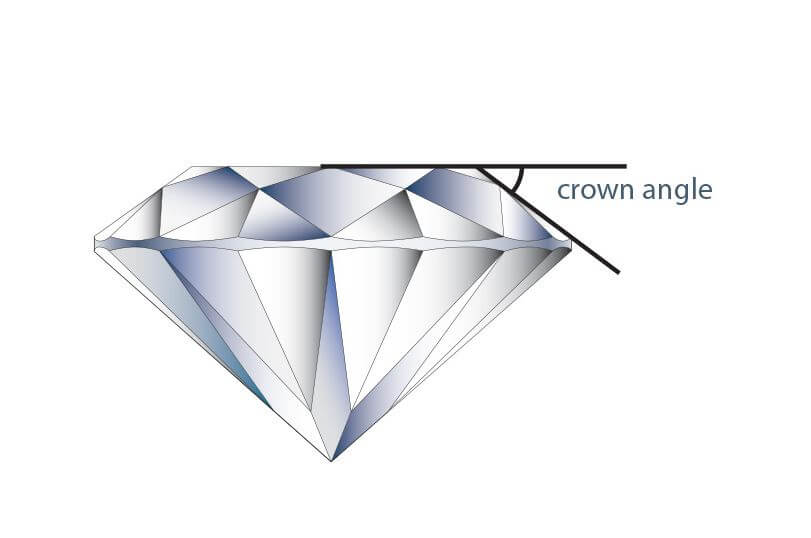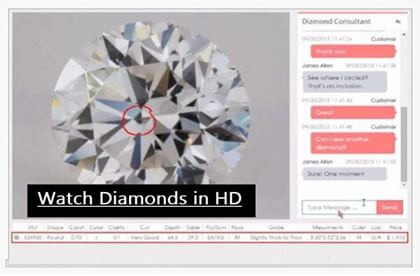Executive Summary
A diamond’s crown is the part of the diamond between the table and the girdle of the diamond. The crown facets are one of the parts of a diamond where light returns from the diamond. The level of light that returns from the crown facet is the level of the diamond’s brilliance.
The crown angle and pavilion angle of a diamond both work together and compensate each other to maximize the light performance of a diamond. The bending of light in the pavilion is compensated for by the crown angle of the diamond. When a diamond’s pavilion angle is steep, the crown angle must be shallow to compensate for the pavilion angle and vice versa. The steeper one is, the shallower the other should be.
A diamond with a shallow crown angle exhibit more brilliance because there is little or no room for light to escape from the diamond. Shallow crown angle changes the dispersion of light by the diamond and therefore changes the way the diamond exhibits its fire. Diamonds with shallow crown angles often display good brilliance but their dispersion of light is poor, so they poorly exhibit fire.
Diamonds with steeper crown angles have a higher crown and a larger crown facet. This allows them to disperse light better and therefore, exhibit a lot of fire. The demerit is, there’s a large tendency for light to leak through a diamond with steep crown angle and this reduces the light reflected back and the brilliance of the diamond.
According to Marcel Tolkowsky, a steep crown angle is 35 degrees and a shallow crown angle is 34 degrees. To compensate for this, a shallow pavilion angle is 40.5 degrees and a steeper pavilion angle is 41 degrees. Therefore, the ideal crown and pavilion angles for diamonds are in-between these figures at 34.5 and 40.75 respectively.
The crown is an important part of a diamond. It is found in between the girdle and table of the diamond. The crown facets, as well as the table facets, acts like windows for the diamond. It is where light returns from the diamond and this ultimately determines the level of the diamond’s brightness.
The crown facets also act as a prism for the diamond, dispersing light and giving off the fire. The amount of fire that a diamond gives off is determined by the size of the diamond’s crown and the crown angle.
The third role which a diamond’s crown facet plays is to bend light. This means that when you look through a diamond crown, what you see is not the same as when you look through the diamond’s table. What you see through the crown is slightly bent or shifted from what you see through the table. The crown facets of diamonds create more virtual facets and this helps to increase the brilliance and sparkle of diamonds by adding to the structured contrast pattern in the diamond.
There is a relationship between the crown angle and pavilion angle of a diamond. They work together and compensate each other in a diamond.
The bending of light in the pavilion is compensated for by the crown angle of the diamond. When a diamond’s pavilion angle is steep, the crown angle must be shallow to compensate for the pavilion angle and vice versa. The steeper one is, the shallower the other should be. This means that for every pavilion angle, there is a crown angle that maximizes its light return.
According to Marcel Tolkowsky, the ideal pavilion angle of a diamond is 40.75 degrees and the ideal crown angle is 34.5 degrees. This means that if you have a diamond with a pavilion angle of 40.6 degrees (and bends light excessively), the ideal crown angle for to compensate for that pavilion angle is a steeper crown angle of 35 degrees. So also if the diamond has a 41 degrees pavilion angle (and does not bend light well enough), the ideal crown angle to compensate for that pavilion angle is a shallower crown angle of 34 degrees.
Going by this analysis, the ideal crown angle for diamonds, to compensate for the different pavilion angles is 34 – 35 degrees. With this, we have two different ideal crown angles, the shallow ideal crown angle and the steeper ideal crown angle and these two are very different from each other.
The Shallow Ideal Crown Angle
A diamond with a shallow crown angle is expected to return light better. This means that these diamonds exhibit more brilliance, and you would expect this since the shallow crown angle gives no room for light to escape from the diamond. Apart from an increased brightness however, this crown angle changes the dispersion of light by the diamond and therefore changes the way the diamond exhibits its fire.
A shallow crown angle means that the diamond is not able to disperse light as much as those with steeper crown angles. This also implies that diamonds with steeper crown angles exhibit more fire than other diamonds with shallow crown angles.
If you prefer to have a bright diamond rather than a diamond that exhibits much fire, it is more appropriate that you settle for a diamond that has a shallow (34 degree crown angle), as long as the pavilion has an angle of 41 degrees (and does not bend light well enough). You just have to ensure that the optical symmetry of the diamond is excellent.
The shallower the crown angle of the diamond is (< 33.5), the lesser the fire of the diamond. But the spread is better with a shallow crown angle. However, diamonds that have very shallow crown angles (< 32.5 degrees) usually have an issue of durability, especially if the diamond also has thin girdles. This is because of the high risk of chipping at the edge of the girdle.
The Steeper Ideal Crown Angle
If the diamond’s table percentage is fixed, a steeper crown angle implies that the diamond has a higher crown and the diamond’s crown facets are larger. This will allow more incident rays to fall on the crowns (which acts as a prism). This incident ray is better dispersed and the diamond exhibits more fire.
The demerit of a steeper crown angle is that the moment you go higher than the 35 degrees crown angle, there is a tendency that the lower girdles of the diamond will start to leak out the light, even if the pavilion angle is 40.8 degrees. The reason this happens is that the angle of the diamond’s lower girdle depends largely on the lower girdle’s length and the diamond’s pavilion angle. So the steeper the diamond gets, the steeper the facets of the lower girdle also.
Standard assessments have discovered that diamonds with steep crown angles only tend to disperse light away from the observer. This implies that it is possible for you to not see the fire that the diamond exhibits but when other people look at the diamond from a different angle, they will notice that it exhibits a lot of fire.
Diamonds with the steeper crown are also known to not have as much spread because most of the diamond weight is invested in the crown height, instead of the width. This causes a reduction in the spread.
Conclusion
The acceptable range for the ideal crown angles for diamonds is 34 – 35 degrees and the acceptable range for the pavilion angles for diamonds is 40.5 – 41 degrees. So, the ideal crown angle for diamonds is unsurprisingly half-way between the range i.e. 34.5 for crown angle and 40.75 for pavilion angle.
A shallow crown leads to an increased brilliance while a steeper crown leads to more light dispersion and consequently more fire. In having to choose from both, many would prefer to settle for the shallow crown because the effect of an increased brilliance makes up for the lack of fire in the diamond.




